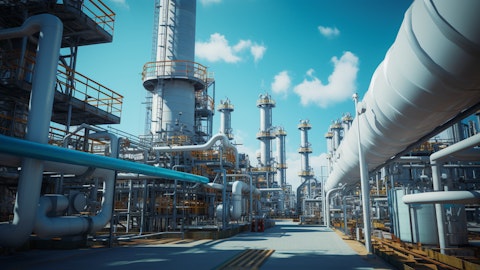So we have been able to keep the breakeven at around $35 per barrel despite inflation. So this is driven by our people constantly chasing improvements. So take Rosebank as an example, where we have reduced FPSO cost by 50% and subsea and drilling cost by 40%. And Geir will give more details on this in the breakout session. Oil and gas is a large part of our future and investments will be stable through the decade. Production is expected to be stable this year, but we expect to see more than 5% growth towards 2026. In 2030, our international production is expected to grow by around 100,000 barrels per day to around 800,000. And behind me here, you see the great Bacalhau FPSO, it will contribute well to the 50% growth in cash flow from the international portfolio.
And Philippe will speak more to this in the breakout session. And as you heard from Kjetil, we are determined to deliver production and cash flow all the way to 2035 from the Norwegian Continental shelf. Behind me, you can also see the expected allocation of capital between Norway and internationally and between existing fields and new fields. We also invest in abatement projects, although relatively small in share, they will have a very large impact on the CO2 reductions. Now over to renewables and low carbon solutions. So today, I want to focus on how the $3 billion in cash flow is built up and the composition of the investment program. Our renewables and low carbon portfolio is now of a materiality where we have line of sight to a significant cash flow in 2030 and beyond.
So far, we have created values through cycle. As we have grown, we have accessed opportunities early. We had divested when prices were high, and we have maintained discipline. So our efforts are starting to pay off. And behind me, you see a list of key contributing assets. And based on a risk in that portfolio, we see a cash flow contribution of around $3 billion by 2030. And we aim to more than double this by 2035 as we have said. Pal and Irene will provide more details in their breakout session. Now to how we allocate CapEx? In 2023, 20% our gross CapEx was towards these two businesses. And as we have said earlier, we aim to increase this to more than 30% in 2025 and to more than 50% by 2030. It is important to note that this is gross CapEx. And it includes project financing in joint ventures, which is not included in the accounts.
So our organic net CapEx or reported CapEx, reported CapEx as we can call it, will be significantly lower as indicated on this slide. We remain value focused and disciplined. So today, we are presenting the capital distribution program for 2024, giving more predictability and a way towards a more effective capital structure. So Anders presented the main elements. In total, the program sums up to $14 billion in 2024 and $8 billion to $10 billion in 2025. The extraordinary cash dividend is based on past earnings, and we intend to continue with $0.35 for the first three quarters of 2024. But after that, we expect to conclude the use of extraordinary cash dividend. For share buyback, we present a two-year program of $10 billion to $12 billion in total.
The first tranche of $1.2 billion will start tomorrow based on the existing approval that has been given from the AGM. We have been clear that we intend to use capital distribution as a tool to achieve a more effective capital structure. So this capital distribution program translates into a total yield of around 17% based on current share price. So before I conclude, let me go over our formal guiding. For 2024, we expect organic net CapEx of around $13 billion and a stable oil and gas production for the year impacted by divestments in Azerbaijan and Nigeria and higher planned turnarounds. For renewables, we expect to double our production. So to sum up, so I hope that we have shown you that we are in a very good position to deliver a stronger and growing cash flow all the way to 2035 from a broader portfolio with lower emissions, while we maintain a strong return on capital employed.
And while we will provide you with a competitive capital distribution. So thank you very much. And then I hand it back to you, Bard, to guide us through the Q&A session. So thank you very much.
Operator: [Operator Instructions]
Bard Glad Pedersen: Thank you, Torgrim, and thank you also to Anders, Kjetil and Hege. Anders will also join on stage here for the Q&A session, and then the executive team is here on the first row and can also take questions. I ask that you use the microphone when you ask questions and that you introduce yourself also for the benefit of those following the webcast. I have had no success in the past by asking you to limit yourself to one question. So therefore I ask at least that you try to limit yourself to two questions each. So then we are ready to go. Maybe Oswald Clint from Bernstein, you want to start? You will get the microphone, yes.
Oswald Clint: Thank you very much. Oswald Clint at Bernstein. Two questions, please. First one, I just want to go through your gas price assumptions, please. You’re $13 next two years and $9 thereafter and the low case is even $8 and $6. So it’s – you guys are experts in natural gas markets. I think the market is probably worried that prices could go a lot lower especially in that thereafter bucket. So just talk about your views now. You talked about Germany, the big contract, the biggest contracts. So is there anything structurally different as you think about gas prices through this next three to five year period, please? Secondly, interesting, you’re stretching out to 2035 when others are contracting to 2025. But this great chart of NCS Norway is quite surprising, especially with the improved oil and gas recovery plus the ILX.
I mean I thought ILX was mostly done. I thought. We played that card last decade, improved recovery. Norway is the leader globally, quite surprised to see so much in the presentation, especially around ocean bottom seismic, which has been around for a while. So maybe just talk more about the confidence here you have what’s changed and 37 prospects around Sleipner and Troll. Can you communicate the success around things like that potentially through the year just to give us confidence? Thank you.
Anders Opedal: Thank you. Great questions. And I start a little bit on both of those, but I also want to bring in Irene on the gas and Kjetil to continue bringing the confidence on the Norwegian continental shelf. But first of all, I found two very interesting data points recently in the gas market. And the first one is, we have seen now really the demand going down with the increased prices and because of the Russian gas going out of the equation. But we see now that the industry demand for gas in Europe, France and Germany is actually picking up. It was a 10% increase over last year, seeing that the energy prices are not necessarily now hampering economic growth and the development of the industry. At the same time, we also see a 9% increase in the gas demand in China.
And actually, China no surpass Europe in demand. So clearly, there are some kind of a turning point in terms of on demand that has been on decline for a while after the war. And then, of course, we have all the weather and so on. So Irene will say a little bit more about this with LNG and some of the recent development there. On the Norwegian continental shelf, ILX gone – no, it’s not. And I think Norwegian continental shelf will surprise and surprise over the next years. Prolific basins tend to be prolific. And based on the knowledge and competence we have built up actually, just the technology has been available, but the uses of the technology and the additional competence that our people bring in to interpret that seismic use in AI to interpret it, finding the anomalies that the human eyes are missing.
This is actually kind of creating the new opportunities. Then, we have the Gas organizations that are able to drill these wells and actually tie them in to an existing platform is in a very efficient manner. So we think we can play this game for many, many, many years on the Norwegian continental shelf. And with the political support to continue with oil and gas, particularly exploration in Norway, Kjetil mentioned the recently awarded licenses, but also the new licenses around for next year is already announced. So there is a lot of positive news around that. But Irene and then Kjetil to follow-up a little bit.





